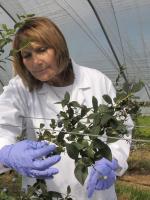Tools and technologies: development of new populations, genotyping tools and methods for trait dissection to support horticultural crop improvement, sustainability and resilience
Project Lead
Challenges
Horticultural crop production in Scotland (and world-wide) faces unprecedented threats because of climate change, the UK no longer participating in the EU’s pesticide regulatory system and other EU exit challenges affecting supply routes and regulation of plant and seed imports/exports. In recent years, many pesticides and other chemicals have lost approval. Future sustainable use of pesticides will likely focus on a whole farm approach using Integrated Pest Management (IPM) with appropriate varieties playing a key role and co-construction of solutions with farmers. This necessitates the development of better more appropriate varieties suited to these new challenges - crops that have consistent yield and quality, as well as resistance to pests, diseases and other stresses, and a smaller environmental footprint.
The identification and utilisation of available genetic diversity within crops are essential to identify those traits that will enable horticulture to be more sustainable and increase the biodiversity in crop production. The shift towards more complex traits that are likely to become increasingly important as climate change progresses and resources become more limited. This necessitates the need to develop new methods and approaches for rapid trait analysis and dissection. Plant imaging and physiological interpretation of those images will play a key role. Genomic tools are constantly evolving, and these play a key role in linking genes to traits, so it is important to continue to develop the most sophisticated platforms for this purpose. More work is needed to develop the tools to allow rapid and meaningful exploitation of the genetic diversity available in horticultural crops to meet future challenges.
Questions
Solutions
This project is using novel plant populations and tools that examine behaviour under complex stresses and examine the plants’ genetic content to develop high quality resilient crops, reducing inputs and allowing the Scottish population to locally source more fruit and vegetables.
In sum, horticultural crop production in Scotland needs to be enabled to reduce its environmental footprint and develop increased resilience. The development of new germplasm and an ability to phenotype and genotype populations for sustainability traits in these genetically complex crops is assisting in breeding programmes. This project is assisting the development of resilient and sustainable crop varieties and production systems that allow the industries to become sustainable.
Population Development and genotyping
This project is enhancing and exploiting germplasm resources using genetic and genomic tools and combining the different datasets to undertake complex aggregated queries across genotype and sequence databases to understand trait control and to support marker development for breeding. We are using genetic approaches to develop crop resources that can be exploited to provide a delivery vehicle for breeding cultivars suitable for future climate change scenarios and enhanced food security. This focus on more complex traits necessitates the development of underpinning phenotyping methods that allow us to understand the underpinning physiological basis of resilient traits using techniques suitable for both controlled environments and field assessments of crops.
For potatoes, we are placing major emphasis on enabling access to traits for abiotic and biotic stress resistances that threaten primary production, with a secondary focus on quality traits identified by stakeholders as being critical to profitability and consumer health. For soft fruits, we are enabling access to abiotic and biotic stress traits that affect yield, resistance, crop ripening, dormancy, and bush architecture; while also taking into consideration those parameters important to growers (resilience to seasonal variability, ease of pick, nutrition, and growing regime) as well as consumers (regional, high quality, sustainable).
Phenotyping tool development
The broader aim of this project is to develop tools and methods for quantitative phenotypic assessment of plant performance in response to multiple and complex stresses. This has significant value in research and breeding for resilience as well as having the potential for methods to be developed on-farm for growers to assess crop performance and conduct precision management. Imaging techniques combined with automated analysis linked to underpinning physiological processes have the potential to provide efficient large-scale high throughput phenotyping data. This was demonstrated previously, however, we are advancing these methods in the following areas:
1. Linking information from high-throughput imaging technologies to the underlying physiological/biochemical plant status.
2. Developing techniques and algorithms for image processing and data extraction from whole plants under both controlled and field conditions.
3. Analysing and understanding the links between crop developmental stage, physiological status and data obtained from different imaging techniques combined with the need to predict plant performance in the field from simple phenotyping methods conducted at an early developmental stage.
Project Partners
Progress
2022 / 2023
The focus of this project is to develop research into resilience traits for both potato and soft fruit as well as both the genetic and phenotypic tools to identify key traits that can then be exploited into elite germplasm.
Population Development and Genotyping:
In Year 1, germplasm has been identified, populations developed and older populations managed for both potato and soft fruit. New single nucleotide polymorphism (SNP) data (genetic data by which to assess variability) has been developed for these crops, while other bioinformatic tools are also being developed. The RubusRTD database now has sequence information and gene expression values for all the reference transcripts. A new genome browser has been created, using JBrowse, to complement the database and several raspberry transcripts datasets have been mapped onto the reference genome and can be viewed in the genome browser.
Phenotyping Tool Development:
Plant imaging that can link spectral signatures to genetics and traits is being developed as a powerful phenotyping tool. Further imaging research has been carried out on potato and raspberry plants, segmentation methods have been develop to identify leaves in potato plants and link with leaf area data, the effect of leaf angle on spectrum of raspberry plants has been investigated. Spectral Quantitative Trait Loci (QTL) and trait associations have been investigated.
Previous Projects
Related Projects
Novel Crops
Novel Crops: To address opportunities for producing alternative protein and carbohydrate crops in Scottish agriculture for fish and crustacean feed, bioenergy, bio-refining, animal feed and human consumption, and to develop design criteria for integrating suitable alternative legume and non-legume crops as sole and intercrops within rotations whilst also accounting for agronomic and ecosystem services.
There are two main areas of research:
Crop Genetic Improvement
The main activities will focus on barley, wheat, potato and soft fruit, the crops of major importance to the Scottish economy. For each crop, the spectrum of capabilities is linked into translational crop genomics pipelines that ultimately deliver improved cultivars. Underpinning research in all projects will be the continued development of novel technologies and approaches including custom platforms for genomic and functional characterisation of important traits.

